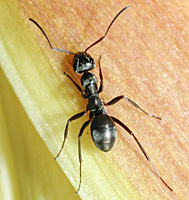[All pictures of garden wildlife on this page are thumbnails. Click on any thumbnail for a large format to be displayed.]

Common Black Ant (Formica fusca)
| Taxonomy | ||||||
|---|---|---|---|---|---|---|
| Kingdom: | Phylum: | Class: | Order: | Family: | Genus: | Species: |
| Animalia | Arthropoda | Insecta | Hymenoptera | Formicidae | Formica | F. fusca |
Of all common black ants this is the biggest. Workers usually reach a length of some 0.9 mm. The Common Black Ant is an extremely active species and they can run very fast indeed. The species is confined to woodland, but it needs far less space than the Red Wood Ant does. So small areas of woodland are often sufficient for this species. Thus it is seen regularly in orchards, grave yards and big gardens or gardens situated at the edge of woodland. This is mainly due to the fact that the nests are relatively small. One nest will hold no more than 500 to 2000 workers. The Common Black Ant is a very timid creature and it rarely bites. It also doesn't make ant hills, but rather lives in rotting tree stumps or underground under stones. The workers of this species will collect whatever they consider edible. Milking aphids however is one of their main food sources. They are also often seen in flowers, eating nectar.
Because the Common Black Ant is not agressive at all, it is often used as a slave by some other ant species. The queen of such a species takes over the nest and the workers of the Common Black Ant work for her. The workers she herself produces often are not capable of working. Maybe as a result of this, the Common Black Ant avoids other ant species. It even doesn't make contact with much smaller species, such as the Black Garden Ant or the Yellow Meadow Ant.
The common Black Ant is widespread throughout the Northern Hemisphere: it lives in Northern America and all of Northern Eurasia. This is a very common species all over Britain.

© Copyright 1998-2024 gardensafari.net (Hania Berdys)

 English / engels
English / engels  Dutch / nederlands
Dutch / nederlands
